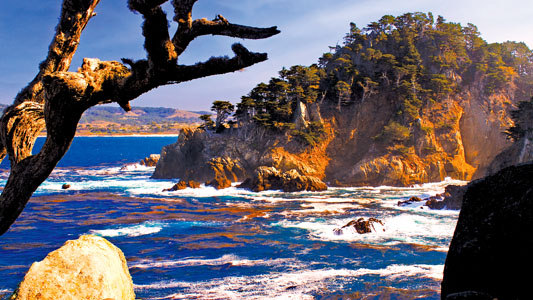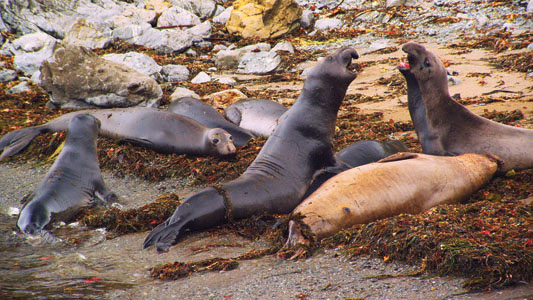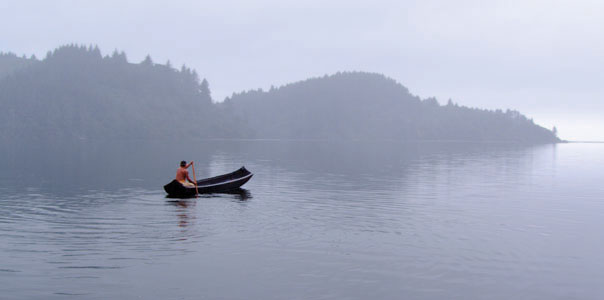In September 12, Backcountry Pictures and KQED will present California Forever, a two-part PBS television special that tells the story of California’s magnificent state parks—from Yosemite in 1864 to the present day.

California Forever, a two-part PBS television special that tells the story of California’s magnificent state parks—from Yosemite in 1864 to the present day — will air on KQED on September 12 at 9 and 10 p.m. The program was filmed in 46 State Parks like Point Lobos State Natural Preserve, pictured above. copyright 2011 – Backcountry Pictures
Published: September, 2012
On September 12, Backcountry Pictures and KQED will present California Forever, a two-part PBS television special that tells the story of California’s magnificent state parks—from Yosemite in 1864 to the present day. Together, the two one-hour programs remind viewers of the importance of California’s state parks as well as their priceless legacy.
"The story of California State Parks is the story of California. It is also the story of the ‘park idea’ and how it spread from California across the country and around the world. The scenic beauty and historic sites that California State Parks protect celebrate our heritage, and helps define what it means to be a Californian," said California Forever writer-director and Academy Award nominee David Vassar. "In California Forever, we hope to encourage viewers to explore state parks in their neighborhoods and across California; to remind them of the priceless legacy that parks protect and to honor the individuals and groups who fought so hard to preserve them over the last 160 years."
Produced by Sally Kaplan and Vassar, the film was inspired by the battle between conservationists and developers over the proposed Orange County Toll Road, which would have paved over a portion of San Onofre State Beach. After witnessing the conflict, the filmmakers felt compelled to tell the story of California’s state parks as a way to remind viewers of these parks and their value.
Episode One:
California Forever: The History of California State Parks highlights the discovery and creation of California’s state parks system and celebrates the individuals and groups whose passion and commitment helped preserve and protect them for future generations. It takes viewers on a scenic, cultural and historical tour of California’s state parks highlighting the people, key events and locales that made California history.
The episode begins with the discovery of the giant sequoias in 1852 by Augustus T. Dowd and recounts the establishment of California’s first state park, Yosemite. Continuing, the narrative moves through the individual stories of citizen action that preserved many of California’s most celebrated landscapes as state parks. Included are the coast redwoods, Big Sur, Point Lobos, Hearst Castle, Lake Tahoe and the Anza-Borrego Desert. While exploring historic places and people who represent crucial chapters of the California story, the plot intersects with many important victories that saved much of California’s most cherished landscape and in the process, inspired the creation of the National Park Service and the protection of wilderness.
Episode Two:
California Forever: Parks for the Future presents the very real challenges that state parks are currently facing in California. Among these are: habitat destruction by overuse; protection of native species at the expense of recreation; reclaiming industrial brown fields to create new parks in dense urban areas; establishing historic sites that commemorate people and events from diverse cultures; and imminent park closures.
This episode highlights the trials of balancing peaceful solitude at Anza-Borrego Desert State Park with the growing demand for "off-roading" at neighboring Ocotillo Wells State Vehicular Recreation Area. It then tells of the wildlife preservation efforts for the northern elephant seal and western snowy plover that sometimes limit public access along parts of the central coast. California Forever stresses the importance of reclaiming land for parks in urban settings, including the "re-wilding" of the Los Angeles River. Additionally, it celebrates the diverse cultures and histories of many groups who made California home, including the Chinese who first arrived at the Angel Island Immigration Station and the freed slaves who created a utopian agrarian community at what is now Colonel Allensworth State Historic Park.
An official selection at the International Wildlife Film Festival, California Forever received the award for Best Educational Program in 2011. It also was selected for screenings at the 2011 American Conservation Film Festival, the 2012 Wild & Scenic Film Festival and the 2012 Environmental Film Festival of Washington, D.C.
In addition to Vassar and Kaplan, California Forever’s creative team includes Christopher Tufty, director of photography; Christian White, editor; Tony Humecke, composer; and Richard Doyle, narrator. The producers scouted more than 100 parks, and the Backcountry Pictures crew shot in 46 of them over a two-year period. The arresting visuals of California’s state parks were acquired at 4k resolution with a RED ONE digital camera.

Bull elephant seals spar at Hearst San Simeon State Park on the Central Coast of California. copyright 2011 – Backcountry Pictures

Zack Brown of the Yurok Nation paddles a traditional redwood dugout canoe across the fog shrouded waters of Humboldt Lagoon State Park on the North Coast of California. A historic recreation staged for Episode One of California Forever, coming to PBS on September 12. copyright 2011 – Backcountry Pictures

